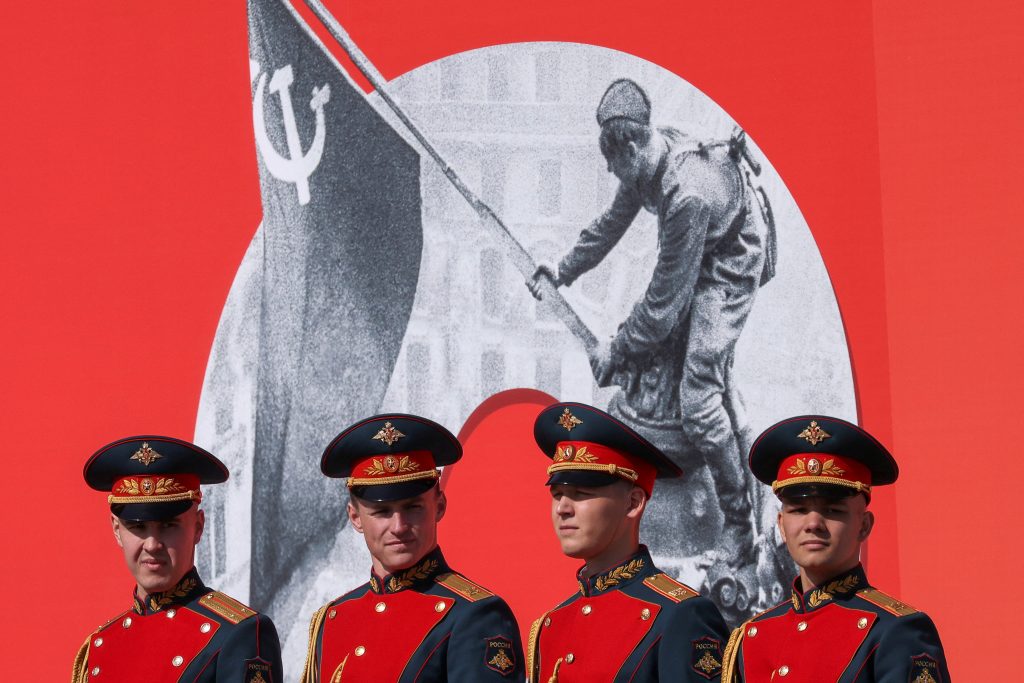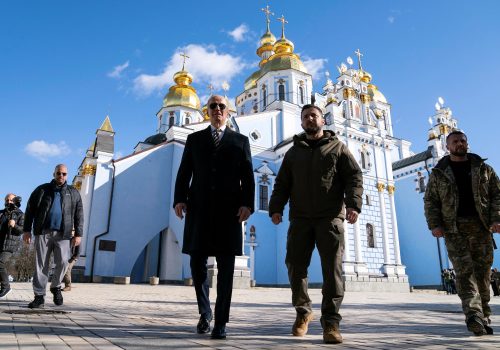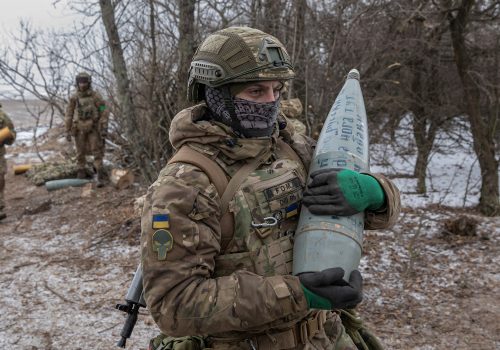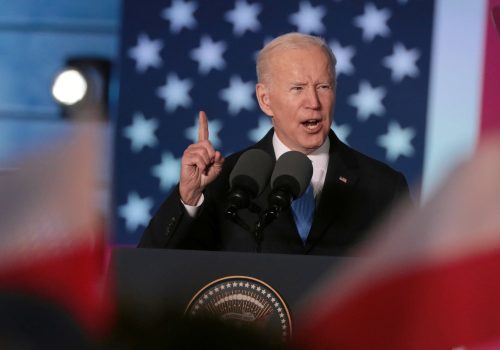As Vladimir Putin’s world-altering war against Ukraine enters its second year, any hope of reviving the post-Cold War European security order depends on defeating Russia in Ukraine. But that will only be the first step in what will be a long struggle—one that calls for an updated strategy of containment.
We, the transatlantic community together with other like-minded democracies, face a long-term strategic confrontation with Russia—a hostile adversarial relationship that will have few guardrails, and where even the modest ambition of peaceful coexistence may be out of reach for a long time to come.
The nature of the Putin regime, its disregard for international law, its brutal suppression of all dissent, its whitewashing of Russian history, plus Putin’s obsession with subjugating his neighbors and reconstituting the Russian empire—all these factors make peaceful coexistence difficult, if not impossible, to conceive in the near and medium term.
Even if developments on the battlefield force Russia to end the war on terms relatively favorable to Kyiv, Putin will not readily abandon his broader revisionist aims. For Putin’s Russia, Ukraine is Ground Zero in its existential war against the West. A winding down of the military conflict is not likely to lead to a reduction in Russia’s efforts to control Ukraine by other means or to dominate its other neighbors, including the Baltic states and other NATO and European Union (EU) members.
Indeed, in non-military domains the conflict is likely to intensify while Russia seeks to rebuild and reconstitute its decimated conventional forces. Information warfare, covert action, sabotage, energy blackmail, counter-sanctions, support for pro-Russian separatists, and other hybrid attacks will all remain active parts of the Russian toolkit against its neighbors and the West. For NATO and the European Union, resilience against hybrid threats will be as important as bolstering defense and deterrence, and the effort to build such resilience should receive significantly more financial support at the national level and in Brussels.
Don’t let Putin seize victory from the jaws of defeat in Ukraine
While Russia grossly underestimated Western unity and resolve, Putin may still hope that allied publics and parliaments will grow tired of supporting Ukraine and bearing the burden of sanctions, just as he hopes to break the will of the Ukrainian people by bombing the country’s civilian infrastructure. As the war grinds on into the spring and summer of 2023, it could devolve into a stalemate. In that case, Russia may count on some allies to revive proposals for early negotiations to freeze the conflict with a ceasefire in place, the first step toward a broader “reset” in relations at Ukraine’s expense.
Russia needs to understand that there can be no normalization of relations until it once again upholds—in deed as well as in word—the fundamental principles laid down in the Helsinki Final Act, Paris Charter, and NATO–Russia Founding Act.
Allied leaders will need to explain to their citizens what is at stake, why a ceasefire in current conditions would only help Putin seize victory from the jaws of defeat, and why it is vital to maintain sanctions and supply advanced weapons to the Ukrainians for as long as it takes to defeat Russia and expel Russian forces from Ukrainian lands. US President Joe Biden hit the right notes in his remarks in Kyiv and Warsaw this week.
Russia needs to understand that there can be no normalization of relations until it once again upholds—in deed as well as in word—the fundamental principles laid down in the Helsinki Final Act, Paris Charter, and NATO–Russia Founding Act. If the United States were to settle for anything less, it would only embolden the Russians to use force to change borders again after they have had time to regroup and rearm. Chinese leader Xi Jinping and other autocrats will happily follow Russia’s example if Putin gets off with little more than a slap on the wrist.
Pursue containment to stop Russian expansionism
To prevent further damage to the rules-based international order, the United States and its allies will need a comprehensive strategy of containment that aims to deter Russia militarily, raises the cost to Russia for its destabilizing behavior, and increasingly decouples Russia from the international community, politically and economically, until Moscow has earned the right to be considered a partner once more.
Containment today is similar to the containment policy enunciated by George Kennan and adopted in the early years of the Cold War. The idea is to stop Russian expansionism, exert forceful counter-pressure on Russian efforts to extend its influence, weaken the Russian regime economically, and conduct an aggressive information campaign to undermine domestic support—the ultimate goal being to encourage the emergence of forces that could liberalize the regime and end the geopolitical competition, as occurred in ending the first Cold War in the 1980s and 1990s.
Containment today benefits from the fact that the Russians are much weaker militarily after the Ukraine war and more isolated politically, although today’s Russia benefits from its close alignment with China and the fact that many nations beyond the democratic West are sitting on the fence.
Containment today also means taking a patient, long-term approach to the promotion of internal change in Russia. While it may be a generation before such change happens, we should be prepared to act quickly when the Russian people themselves demand leaders who are ready to return to the path of cooperation and integration that Putin has abandoned.
While it may be a generation before such change happens, we should be prepared to act quickly when the Russian people themselves demand leaders who are ready to return to the path of cooperation and integration that Putin has abandoned.
Military strength and Alliance cohesion are the foundation of an effective containment policy. We need a NATO- and EU-coordinated strategy to push back against all forms of Russian expansionism, in Ukraine and beyond, and to strengthen our resilience against conventional and hybrid warfare.
In the short term, we need to commit unambiguously to the goal of Ukrainian victory. We should help Ukraine capitalize on its successful counter-offensives by boosting and accelerating the supply of heavy weapons, long-range strike systems, and air and missile defense that can inflict further defeats on Russia in the weeks and months ahead, while increasing economic and humanitarian assistance at the same time.
For Ukraine to prevail, we need to speed up the weapons delivery process and restart production of the most urgently needed systems such as High Mobility Rocket Artillery Systems (HIMARS) and advanced drones, both to secure new gains for the Ukrainians and to replenish depleted allied stocks.
We need to calibrate what weapons we provide to avoid escalation, but we should not let ourselves be intimidated or self-deterred by Russian saber-rattling. Putin is more interested than we are in avoiding a direct clash with NATO, conventional or nuclear, and he understands that any use of nuclear weapons, even a “demonstration” strike, would open Pandora’s box and fundamentally change the nature of the war.
Right now, it is the Russians who are doing the escalating, with their barbaric missile and drone attacks on civilian infrastructure and terrorization of the Ukrainian people.
In my view, it is time to reconsider our self-imposed range limits and provide systems that enable Ukraine to deny the Russians a sanctuary for launching their infrastructure attacks. If the Russians can strike with impunity from Crimea or across the Russian border, they will continue to escalate, at horrific human cost. Enabling Kyiv to target those systems is not escalation, but legitimate self-defense.
Press pause on the NATO–Russia Founding Act
Beyond helping Ukraine prevail, NATO’s number one defense priority is to implement the forward-looking decisions at the 2022 Madrid summit on deterring and defending against threats to allied territory. The Russians have suffered enormous losses of military equipment and manpower. But like the Terminator, they will be back.
As agreed at Madrid, NATO needs to move expeditiously from forward presence to forward defense, with larger forces along the eastern flank able to repel any attempted land grab and not simply serving as tripwires. In particular, NATO needs to fully implement the decision to expand from battalion-sized battle groups to brigade-sized forces in the east as part of the shift to deterrence by denial.
Establishing the new force model could be easier if allies declared that they are no longer bound by the constraints in the NATO–Russia Founding Act on permanent stationing of substantial combat forces, given Russia’s flagrant violations of that document. This would allow a mix of permanent and rotational deployments, which would be more effective than rotational forces alone.
Ending NATO’s self-imposed constraint on deploying nuclear weapons on the territory of NATO’s post-Cold War members could bolster deterrence and allied cohesion by spreading responsibilities and risks among a larger number of allies.
The NATO–Russia Founding Act could be suspended rather than terminated. But it makes no sense to pretend that the security environment after Russia’s invasion of Ukraine is anywhere comparable to the more benign security environment in 1997 when the act was signed.
In the face of Putin’s nuclear saber-rattling since the invasion of Ukraine, allies also need to undertake a more serious review of NATO’s nuclear posture and policy than that reflected in the Biden administration’s recent Nuclear Policy Review.
In addition to threatening “catastrophic consequences” for any Russian use of nuclear weapons, we must be sure we have a wide enough set of non-strategic capabilities to defeat the Russian “escalate to deescalate” strategy under any scenario. In this regard, developing a new nuclear-armed sea-launched cruise missile would be a valuable addition to the US force mix.
This may be another area where we should review commitments under the NATO–Russia Founding Act and consider bringing more allies into the Alliance’s nuclear-sharing arrangements. Ending NATO’s self-imposed constraint on deploying nuclear weapons on the territory of NATO’s post-Cold War members could bolster deterrence and allied cohesion by spreading responsibilities and risks among a larger number of allies.
Just raising the possibility could be effective as leverage to persuade the Russians to accept verifiable constraints on their non-strategic nuclear weapons. For the United States and NATO, limiting Russian non-strategic systems is a sine qua non for any successor to the New Strategic Arms Reduction Treaty, known as New START. Putin put that treaty’s future in doubt with his recent announcement that Russia is suspending implementation.
Aim for Europe to evenly shoulder collective defense by 2030
In implementing the Madrid summit’s decisions, NATO needs to move toward a more balanced sharing of responsibility across the Atlantic. Even before the 2022 US midterm elections, concerns were growing among congressional Republicans about burden-sharing and allied free-riding, and this could become an even bigger concern in the 2024 US presidential election.
European allies could head off a future transatlantic rift by committing now to produce and deploy, by the end of this decade, at least 50 percent of the capabilities that NATO requires for collective defense. This would also be a prudent hedge in case the United States should need to divert some of its NATO reinforcements to the Indo-Pacific theater to deal with a simultaneous China crisis.
Ensuring that European countries provide half of the capabilities and enablers for collective defense will also make it possible for Europe to become the first responder for managing crises along NATO’s periphery. That would be a tangible demonstration of greater strategic responsibility for Europe in its own neighborhood.
As NATO strengthens its own deterrence posture, the Alliance should take on a formal, long-term role in helping all of Russia’s vulnerable neighbors strengthen their own deterrence capabilities and their resilience against cyber and other hybrid threats. This could be called the “Secure Neighborhood Initiative.”
Unfortunately, it is clear that for the foreseeable future allies will remain reluctant to give NATO membership and an Article 5 security guarantee to Ukraine, Georgia, or any other former Soviet state, no matter how deserving and qualified they may be. While NATO membership should be the long-term goal, the next-best thing allies can do now is to ensure that these vulnerable partners acquire the capabilities, training, and intelligence needed to deter and, if necessary, defeat Russian aggression. A commitment to that effect could form the core of security guarantees for Ukraine under a potential peace agreement to end the war.
Ensure containment goes beyond defense
An effective containment strategy should also seek to maximize Russia’s economic and political isolation. Economic decoupling should be achieved through a long-term policy of sanctions on the Russian economy and following through on moves to end the West’s dependence on Russian energy and raw materials.
In terms of political isolation, we need to treat Russia as a pariah or rogue state and avoid any premature return to business as usual. We should not rule out future discussions on arms control and strategic stability, while recognizing the difficulty of negotiating new agreements with a Russia that has violated every existing agreement and has behaved recklessly in occupying the Zaporizhzhia nuclear power plant in southern Ukraine.
While isolating Russia politically, we should look for ways to engage with Russian civil society and the growing number of political oppositionists operating from exile in neighboring countries. This should include efforts to connect to the next generation of potential leaders, making clear that our issues with Russia are with the policies of the regime, not the Russian people.
The death of Mikhail Gorbachev last year is a reminder that it was internal change that ended the first Cold War forty years after it began. It may take decades to happen this time around, but we should be ready to engage with a better Russia when it appears.
Alexander Vershbow is a distinguished fellow at the Atlantic Council. He is a former US ambassador to NATO, Russia, and South Korea; US assistant secretary of defense for international security affairs; and NATO deputy secretary general. This article is adapted from a speech Vershbow delivered to the NATO Parliamentary Assembly in December.
Further reading
Mon, Feb 20, 2023
Experts react: One year after Russia’s invasion of Ukraine, the US releases new sanctions and China steps in with a ‘peace’ plan
New Atlanticist By
Atlantic Council experts share their insights on the importance of Biden's surprise trip to Kyiv and more at the one-year mark of Russia's full-scale invasion of Ukraine.
Thu, Feb 9, 2023
Policymakers: Keep Ukrainian soldiers front of mind as this war of attrition continues
New Atlanticist By Justin M. Conelli
As the war reaches the one-year mark, leaders concerned about grand strategy need to weigh the suffering and resilience of the soldiers at the front.
Fri, Feb 17, 2023
What Biden should say in Poland: No Russia reset while Putin is in power
New Atlanticist By Daniel Fried
President Joe Biden is going to Warsaw to mark one year of war. Other than Ukraine itself, there is no better place than Poland for Biden to show what is at stake.
Image: Russian service members line up before a rehearsal for a military parade marking the anniversary of the victory over Nazi Germany in World War Two in Red Square in central Moscow, Russia May 7, 2022.



